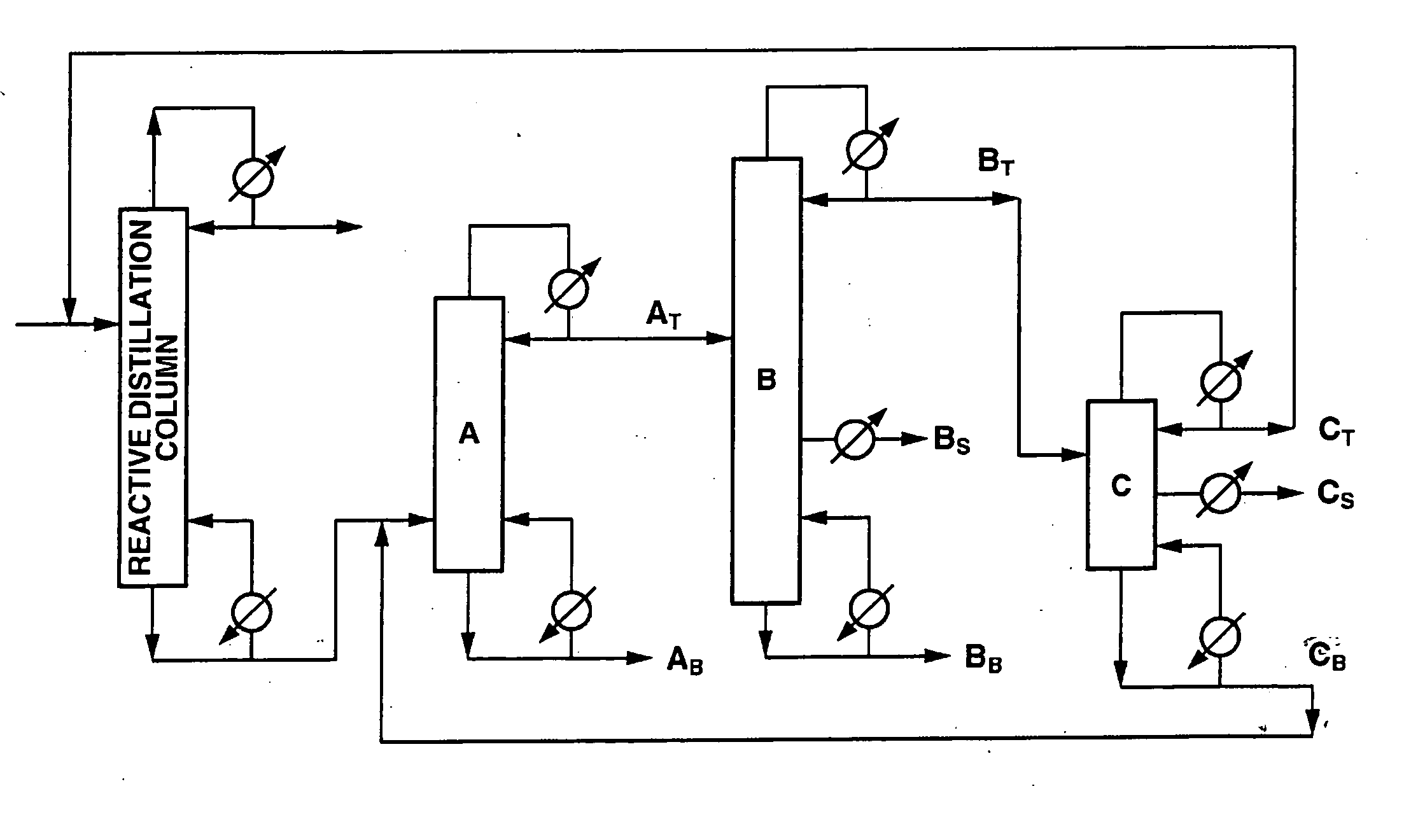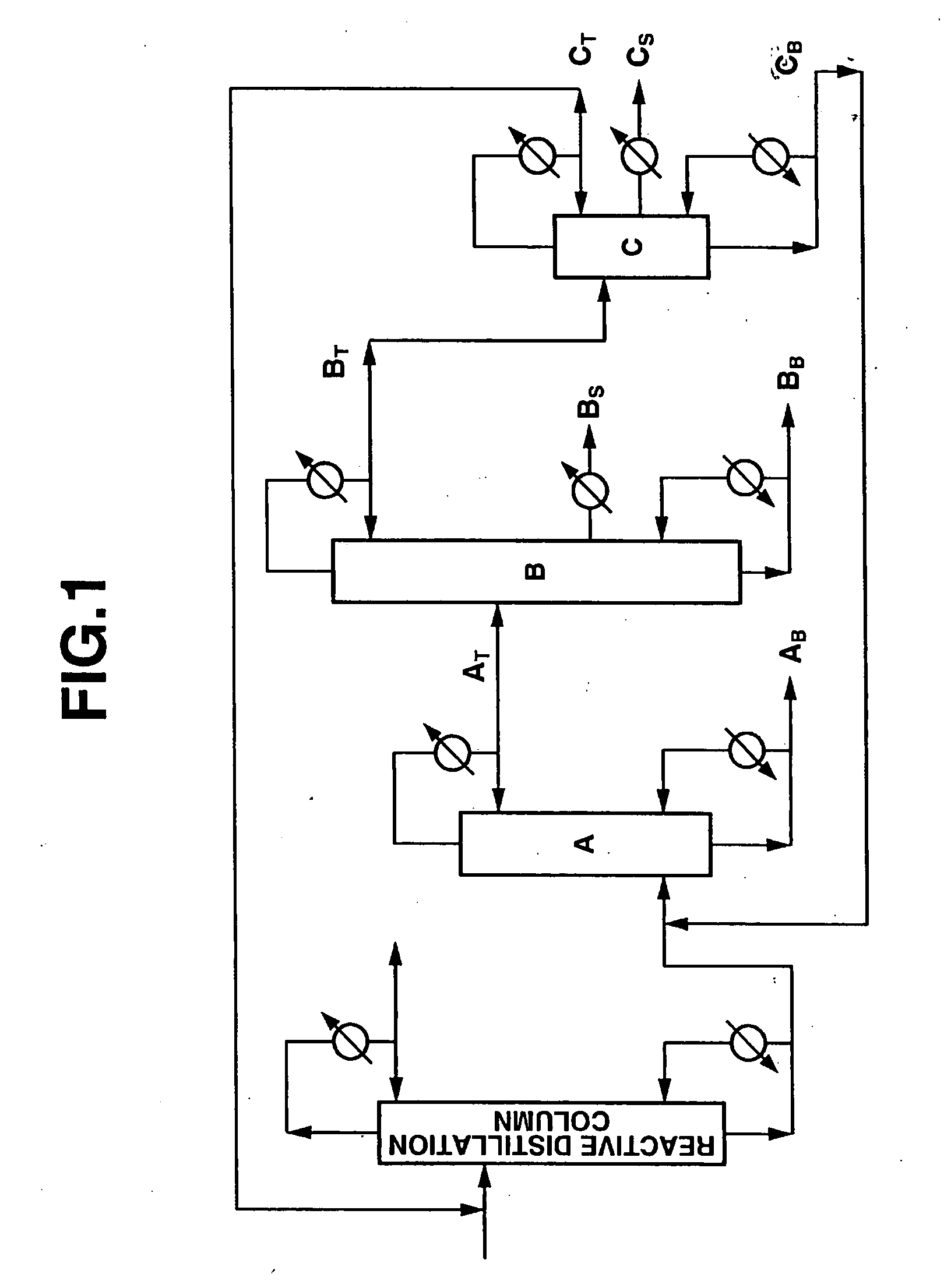Process for Production of High-Purity Diaryl Carbonate
a diaryl carbonate, high-purity technology, applied in the direction of carbonic/haloformic acid esters purification/separation, separation processes, sustainable manufacturing/processing, etc., can solve the problem of reducing the yield of aromatic carbonate, unable to use as raw material for the production of aromatic polycarbonate, and unable to achieve economic effect of carrying out the method, etc. problem, to achieve the effect of stably producing
- Summary
- Abstract
- Description
- Claims
- Application Information
AI Technical Summary
Benefits of technology
Problems solved by technology
Method used
Image
Examples
example 1
[0113] Diphenyl carbonate was produced using an apparatus comprising a reactive distillation column (height: 6 m, diameter: 10 inches, internal: sieve tray, number of stages: 20), a high boiling point material separating column A (height: 5 m, diameter: 6 inches, internal: Dixon packing, theoretical number of stages: 25), a diaryl carbonate purifying column B (height: 8 m, diameter: 6 inches, internal: sieve tray, number of stages: 30) and an intermediate boiling point material separating column C (height: 4 m, diameter: 2 inches, internal: Dixon packing, theoretical number of stages: 15) as shown in FIG. 1.
[0114] A reaction mixture containing 18.7% by weight of methyl phenyl carbonate that had been obtained by subjecting phenol and dimethyl carbonate containing anisole to a transesterification reaction was used as a starting material. This starting material contained 27.5% by weight of dimethyl carbonate, 8.2% by weight of anisole, 43.9% by weight of phenol, 1.5% by weight of diph...
example 2
[0123] Reactive distillation and separation / purification by distillation were carried out using the same process as in Example 1, except that the conditions for the separation / purification by distillation were changed to a column bottom temperature of 210° C., a column top pressure of 3800 Pa, and a reflux ratio of 0.61 for the high boiling point material separating column A, a column bottom temperature of 220° C., a column top pressure of 6700 Pa, and a reflux ratio of 1.5 for the diaryl carbonate purifying column B, and a column bottom temperature of 200° C., a column top pressure of 2400 Pa, and a reflux ratio of 0.35 for the intermediate boiling point material separating column C. The purity of the diphenyl carbonate after 500 hours and 1000 hours was at least 99.999% by weight, and each of intermediate boiling point by-products and high boiling point by-products was undetectable, the content thereof being not more than 1 ppm. Moreover, the halogen content of the diphenyl carbon...
example 3
[0124] Using the diphenyl carbonate obtained in Example 1, an aromatic polycarbonate was produced using the process described in example 1 in International Publication No. 99 / 64492. The obtained aromatic polycarbonate having the number average molecular weight of 10500 was injection molded at 310° C. into a test piece (3.2 mm thickness). This test piece had b* value of 3.2 (this value indicating a yellowness in accordance with a CIELAB method) and no yellow tinge, and was uncolored, which was excellent in transparency. After crushing these test pieces by a crushing machine, injection molding of the crushed pieces at 310° C. was repeated five times, whereupon the b* value of the test piece thus obtained was 3.5, and hence marked discoloration was not observed. Moreover, a heat resistance ageing test (120° C., 500 hours) was carried out on the test piece (b* value=3.2) produced by injection molding the above aromatic polycarbonate, whereupon the b* value was 3.5, and hence marked disc...
PUM
| Property | Measurement | Unit |
|---|---|---|
| Temperature | aaaaa | aaaaa |
| Temperature | aaaaa | aaaaa |
| Fraction | aaaaa | aaaaa |
Abstract
Description
Claims
Application Information
 Login to View More
Login to View More - R&D
- Intellectual Property
- Life Sciences
- Materials
- Tech Scout
- Unparalleled Data Quality
- Higher Quality Content
- 60% Fewer Hallucinations
Browse by: Latest US Patents, China's latest patents, Technical Efficacy Thesaurus, Application Domain, Technology Topic, Popular Technical Reports.
© 2025 PatSnap. All rights reserved.Legal|Privacy policy|Modern Slavery Act Transparency Statement|Sitemap|About US| Contact US: help@patsnap.com


